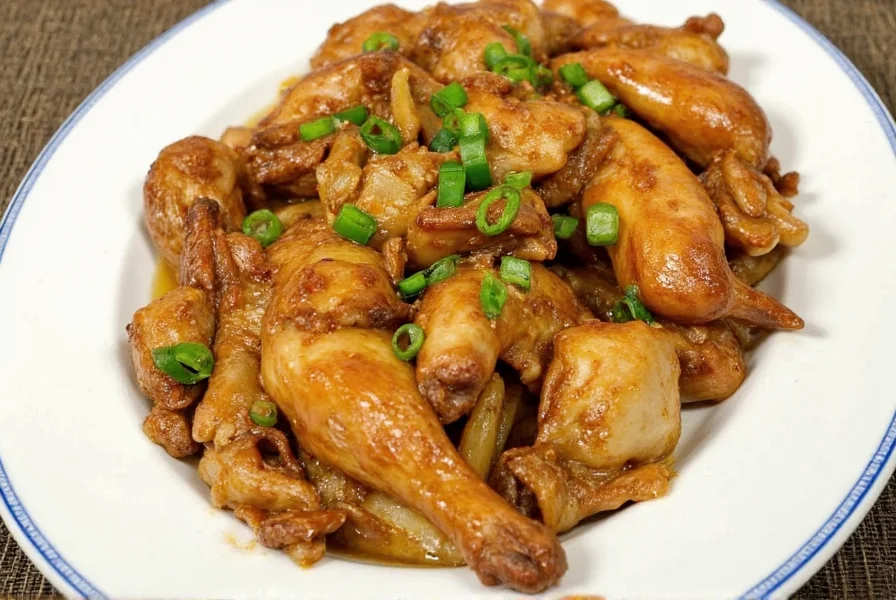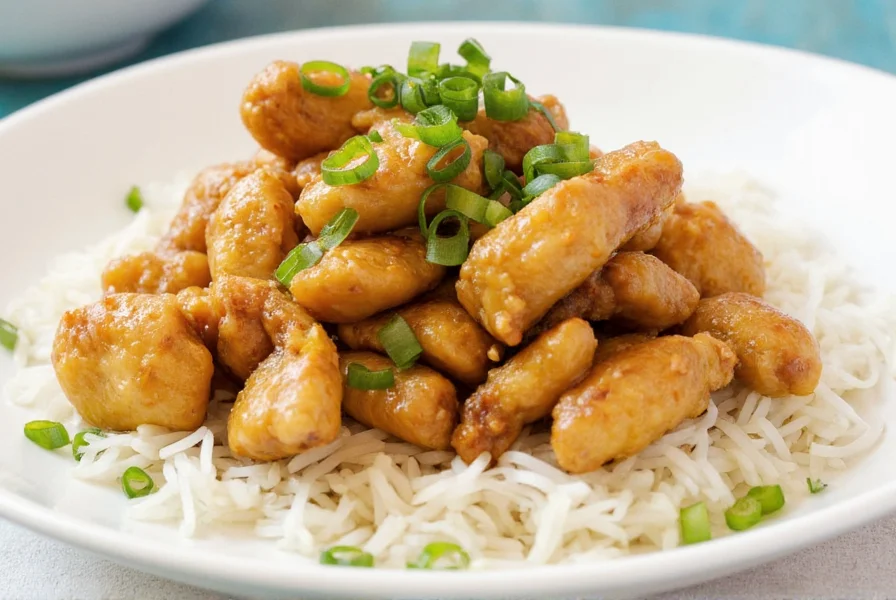If you're searching for a flavorful, restaurant-quality ginger chicken dish you can make at home, this recipe delivers exactly that. Unlike versions using powdered ginger, this recipe highlights fresh ginger root's bright, zesty flavor that transforms ordinary chicken into something extraordinary. The secret lies in properly preparing the ginger and balancing the sauce ingredients for maximum flavor impact.
Why Fresh Ginger Root Makes All the Difference
While ground ginger has its place in baking, fresh ginger root contains volatile oils that give this dish its signature aromatic punch. When sliced paper-thin or julienned, fresh ginger releases gingerol compounds that provide both flavor and potential health benefits. The texture contrast between tender chicken and slightly crisp ginger strands creates a delightful eating experience you simply can't achieve with powdered alternatives.
Essential Ingredients for Authentic Flavor
The magic of this ginger root chicken recipe comes from quality ingredients in precise proportions. Don't substitute fresh ginger with ground here—this is where the dish earns its name and distinctive character.
| Ingredient | Amount | Preparation Notes |
|---|---|---|
| Chicken breast or thigh | 1.5 lbs | Cut into 1-inch pieces |
| Fresh ginger root | 3 oz (about 1/2 cup) | Peel and slice into matchsticks |
| Garlic | 4 cloves | Minced |
| Soy sauce | 3 tbsp | Low sodium preferred |
| Rice vinegar | 1 tbsp | For brightness |
| Honey or brown sugar | 1 tbsp | For balanced sweetness |
| Sesame oil | 1 tsp | Added at the end |
| Green onions | 2 | Sliced for garnish |
Step-by-Step Cooking Instructions
Follow these professional kitchen techniques to achieve perfect ginger chicken every time:
- Prepare the ginger: Peel fresh ginger root using the edge of a spoon (works better than a peeler), then slice into thin matchsticks. This "brisé" cut maximizes surface area for flavor release while maintaining pleasant texture.
- Marinate the chicken: Toss chicken pieces with 1 tbsp soy sauce, 1 tsp cornstarch, and 1 tsp rice vinegar. Let sit 15 minutes—this tenderizes the meat and helps the sauce cling better.
- Stir-fry technique: Heat 2 tbsp oil in a wok or heavy skillet over medium-high heat. Add ginger and garlic, stirring constantly for 30 seconds until fragrant but not browned.
- Cook the chicken: Add marinated chicken in a single layer. Cook undisturbed for 2 minutes to develop fond (those delicious browned bits), then stir-fry 3-4 minutes until mostly cooked through.
- Create the sauce: Pour in remaining soy sauce, honey, and 2 tbsp water. Bring to a simmer and cook 2-3 minutes until sauce thickens slightly and coats the back of a spoon.
- Finish properly: Remove from heat and stir in sesame oil. Garnish with sliced green onions before serving.

Pro Tips for Perfect Ginger Chicken
These professional cooking techniques elevate your fresh ginger root chicken recipe from good to exceptional:
- Ginger preparation matters: Never use a grater for this recipe—thin slices provide the ideal texture contrast. For milder flavor, blanch ginger slices in boiling water for 30 seconds first.
- Temperature control: Keep heat at medium-high but never smoking hot. Excessive heat burns ginger, creating bitterness.
- Sauce consistency: The perfect ginger chicken sauce should lightly coat the ingredients without pooling at the bottom of your bowl.
- Don't overcrowd the pan: Cook chicken in batches if necessary to ensure proper browning, which builds flavor foundation.
Serving Suggestions and Pairings
This versatile ginger root chicken recipe pairs beautifully with:
- Steamed jasmine or basmati rice (the perfect sauce vehicle)
- Simple stir-fried bok choy or broccoli
- Cucumber salad with rice vinegar dressing
- Light Asian-style slaw
For a complete meal, serve with miso soup and edamame. The ginger's warming quality makes this dish particularly satisfying during cooler months, but its bright flavors work year-round.
Storage and Reheating Instructions
Store leftovers in an airtight container in the refrigerator for up to 3 days. When reheating ginger chicken:
- Best method: Gentle reheating in a skillet with 1-2 tsp water to revive the sauce
- Microwave option: Cover and heat at 50% power in 60-second intervals
- Do not freeze: The sauce texture deteriorates upon thawing
- Revive leftovers: Add fresh ginger matchsticks when reheating for bright flavor boost
Recipe Variations to Try
Once you've mastered the basic fresh ginger chicken recipe, experiment with these authentic variations:
- Szechuan style: Add 1 tsp Szechuan peppercorns and 1 chopped red chili for numbing heat
- Ginger chicken with vegetables: Include bell peppers, snap peas, and carrots in the last 2 minutes of cooking
- Creamy ginger version: Stir in 2 tbsp coconut milk at the end for a Thai-inspired twist
- Low-carb option: Serve over cauliflower rice and replace honey with 1/2 tsp stevia
Understanding Ginger's Culinary Role
Fresh ginger root isn't just a flavoring—it's a cooking technique. When added early in the cooking process, ginger infuses the entire dish with warmth. Added at the end, it provides bright, spicy notes. This ginger root chicken recipe strategically uses ginger at multiple stages for layered flavor. The enzyme zingibain in fresh ginger also helps tenderize proteins, which is why many Asian marinades feature ginger prominently.

Frequently Asked Questions
Can I substitute ground ginger for fresh ginger root in this recipe?
No, ground ginger won't work as a substitute in this fresh ginger root chicken recipe. Ground ginger has completely different flavor compounds and lacks the bright, zesty quality of fresh ginger. You'd need about 1/4 teaspoon ground ginger to approximate the heat of 1 tablespoon fresh, but the flavor profile would be entirely different and much less vibrant. Fresh ginger's texture also contributes to the dish's appeal.
How do I properly peel and prepare ginger root for this recipe?
The best method for peeling ginger root is using the edge of a spoon—it removes just the thin skin without wasting flesh. For this ginger chicken recipe, slice the peeled ginger into thin matchsticks (about 2 inches long and 1/8 inch thick) rather than mincing. This "brisé" cut provides the ideal texture contrast against the tender chicken while maximizing flavor release during cooking.
Why does my ginger chicken turn out watery?
Ginger chicken becomes watery when the chicken hasn't been properly dried before cooking or when too much liquid is added to the sauce. Always pat chicken pieces dry before marinating, and ensure your sauce reduces sufficiently—look for it to coat the back of a spoon. Using cornstarch in the marinade (as in this recipe) also helps thicken the sauce naturally as it cooks.
What's the best type of chicken to use for ginger chicken?
Both chicken breast and thigh work well in this ginger root chicken recipe, but they create different eating experiences. Breast provides leaner, more delicate flavor that lets the ginger shine, while thigh offers richer taste and stays more moist during cooking. For best results, cut whichever you choose into uniform 1-inch pieces to ensure even cooking. Never use pre-cooked chicken as it will become tough when reheated in the sauce.











 浙公网安备
33010002000092号
浙公网安备
33010002000092号 浙B2-20120091-4
浙B2-20120091-4